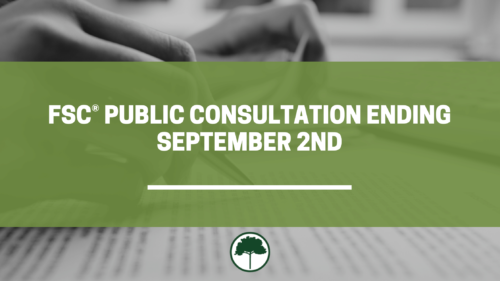
FSC® has a public consultation that is about to end on September 2nd, CONSULTATION ON JOINT REVIEW REPORT OF FSC STD-40-004 & FSC STD-20-011-V4. This is the first step in the process of revising the Chain of Custody standard (40-004), which will be coming down the pipeline soon. You may access this consultation here, https://consultation-platform.fsc.org/en/consultations/. You will need to create a login. But it will be worth it.
This first step involves a white paper issued by FSC that discusses all the possible topics that FSC would like to consider for the revision of the standard. To us, there are a number of potentially concerning topics that are raised in this paper, that bear comment. Without running through the entirety of my thoughts on each topic, I have included our submitted comments below. We encourage you to make them your own and submit comments.
Chris
American Green comments, authored by Christopher Gibbons
Page 1 – Answer as appropriate to your situation
Page 2 – pertinent comments:
3.ii. Valid output claims for pre-consumer reclaimed wood – We support this change. For example, say a CH buys wood shavings from primary and secondary manufacturers to sell to pellet manufacturers or use in glue-based products that need some wood “flour” or to make chips, etc. These are pre-consumer because they’re “co-product” or “bi-product” of sawing, milling, planning, sanding, etc. Some inputs could be FSC 100% products, and could be sold as FSC 100% chips. However, the amount of segregation required for that on a “waste product” makes it almost impossible for large scale sawmills/manufacturers. So, companies who want these typically try to get them as Controlled Wood. However, as we know, if they have just ONE source that cannot be mitigated, then all that waste material becomes ineligible as FSC Controlled Wood. This clause would help to include materials that otherwise are unnecessarily being excluded. In the world of “reduce, reuse, recycle”, this falls under “reduce”.
- Improving clarity for requirements on outsourcing activities and contractors – If “improving clarity” means reducing the amount of paperwork that Core Labor seems to have introduced to outsourcing agreements, with no actual benefit or positive outcome, then we support this.
- Expanding the universal requirements – FSC seems hell bent on reducing the organization to a niche or boutique certification. We say this because the breadth of major changes to the system that seem to crash upon CHs like waves recently (CW NRAs, Core Labor, AAF) drives many organizations to sour on participating. Yes, they may stay certified for one or two key clients, but they view FSC as a burden to be shouldered rather than an accomplishment to be touted. And as soon as they lose their direct impetus to maintain certification, they drop it. The suggested ‘strengthening’ may be admirable, but it needs to be reviewed with an eye toward the realization that no progress can be made by a defunct or passed by organization. This isn’t to say that these topics shouldn’t be reviewed and addressed, we simply want to ensure that the resulting impact on the system is part of the review.
- Evaluating disassociated organizations operating as outsourcing contractors – Asking organizations that already have an acrimonious relationship to FSC to do something for FSC certified organizations is doomed to failure. If the purpose of this clause is to absolve CHs from worrying about working with disassociated organizations because the onus is on the disassociated organization, then this is effective. If the goal is to not provide outsourced FSC work to disassociated organizations, then this clause is not effective.
- Developing mechanisms to address integrity issues and risks associated with high-risk supply chains – This is a fine topic to explore, however we have concerns about the idea of developing new “instruments and solutions” to address this issue. We would like to reiterate Occam’s Razor, i.e. “the simplest solution is always the best”. The FSC standards do not need a completely new concept introduced to them, when we have existing systems to address the same issue.
- Aligning with FSC IT initiatives: database, online reporting and blockchain technology – First, fix info.fsc.org. The disaster that is the current website has created far reaching and unforeseen consequences up and down the supply chain, creating auditing nightmares that are truly forcing some CHs to leave the system.
With that said, we strongly support FSC’s continuous improvement goals in the IT realm.
At the same time, we also have significant concerns about the promises of blockchain. See this article as an example of potential pitfalls of blockchain overall, https://www.technologyreview.com/2018/04/25/143246/how-secure-is-blockchain-really/. Blockchain is not the panacea that its proponents claim. Additionally, these tech heavy processes disproportionately impact our smallest CHs, who simply do not have the resources to learn and implement these processes. We encourage FSC to take a long and hard look at these IT processes and concentrate on basic improvements of the user experience that can be accomplished simply (see motion 55 as an example), rather than chasing the newest flight of IT fancy.
- Improving the treatment of species information within the CoC system – Seems to unnecessarily complicate things. We’d like to see more information about why this is important.
- Facilitating the sale of FSC products with FSC claims for online marketplaces / e-commerce sites – We support this as an important recognition that the FSC standards have to react to the reality of the marketplace, not the other way around.
- Merging Multiple Sites (plus related normative documents) and Reclaimed materials standards – This is an absolutely terrible idea. It may make FSC’s processes simpler, though we even are unsure of that, but it most definitely will reduce the user experience of CHs in a myriad of ways. Lock this idea up and throw away the key.
Page 3 – pertinent comments
- Evaluating of group and multisite chain of custody certificates group sampling requirements – This is a solution in search of a problem. In fact, there is already a process in place that CBs can use to increase scrutiny of group certificates, namely Table A. Matrix for determination of R (risk index) in 20-011. This proposed addition adds increasingly onerous requirements to all group certificates, based either on the actions of a few or the apparent institutional discrimination against small businesses that FSC/ASI/CBs continue to practice without cause. Continuously throwing roadblocks, whether financial (in this case because of increased audit costs) or other (think about blockchain), in front of small businesses, makes a mockery of FSC’s repeated desire to support small businesses/smallholders.
- Incorporating remote and hybrid surveillance evaluations – Yes, absolutely, include this. The carbon footprint of FSC chain of custody auditing is an international embarrassment. Make sure to include internal audits in this as well.
- Restructuring and reviewing the content of evaluation reports – Many organizations, CBs and internal auditing organizations, have spent many tens of thousands of dollars, or more, on creating audit reports. These reports often are tailored, and part of the benefit provided, by the providing organization. Standardization here provides no measurable gain for all, while providing measurable losses for some.
Certificate holders and Economic chamber impacts: Changes to 40-004/20-011, as FSC/CB/ASI try to figure out how to audit against them, disproportionately impact CHs every time. With the “minor” change of Core Labor and the change of the AAF policy still making waves, minimizing CH impacts has to be a priority to keep the entire CoC system stable.
Table X – Risk Determination for undertaking remote… audits – this table appears to be based on the theoretical principles of how businesses might operate, rather than actual risks based on an understanding of impacted businesses. However, we strongly support the inclusion of this table and the concept underpinning it.
